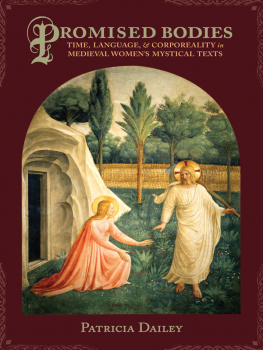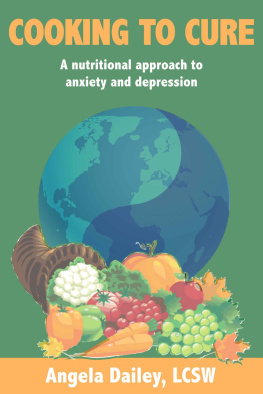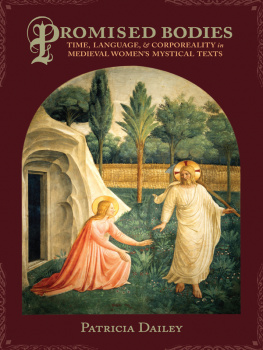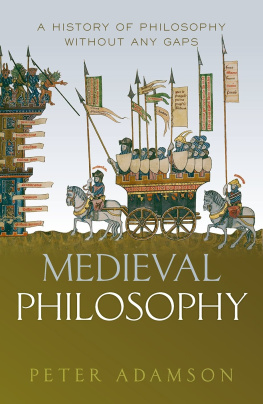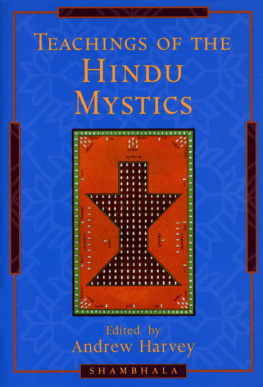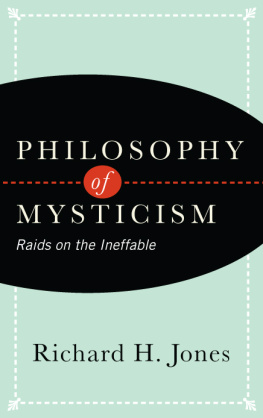PROMISED BODIES
Gender, Theory, & Religion
Gender, Theory, & Religion
Amy Hollywood, Editor
The Gender, Theory, and Religion series provides a forum for interdisciplinary scholarship at the intersection of the study of gender, sexuality, and religion.
Martyrdom and Memory: Early Christian Culture Making,
Elizabeth A. Castelli
When Heroes Love: The Ambiguity of Eros in the Stories of Gilgamesh and David,
Susan Ackerman
Abandoned to Lust: Sexual Slander and Ancient Christianity,
Jennifer Wright Knust
Naming the Witch: Magic, Ideology, and Stereotype in the Ancient World,
Kimberly B. Stratton
Dying to Be Men: Gender and Language in Early Christian Martyr Texts,
L. Stephanie Cobb
Between a Man and a Woman? Why Conservatives Oppose Same-Sex Marriage,
Ludger H. Viefhues-Bailey
PROMISED BODIES
TIME, LANGUAGE, & CORPOREALITY IN MEDIEVAL WOMENS MYSTICAL TEXTS
Patricia Dailey
COLUMBIA UNIVERSITY PRESS
NEW YORK
Columbia University Press
Publishers Since 1893
New York Chichester, West Sussex
cup.columbia.edu
Copyright 2013 Columbia University Press
All rights reserved
E-ISBN 978-0-231-53552-6
Library of Congress Cataloging-in-Publication Data
Dailey, Patricia.
Promised bodies: time, language, and corporeality in medieval womens mystical texts / Patricia Dailey.
pages cm. (Gender, theory, and religion)
Includes bibliographical references and index.
ISBN 978-0-231-16120-6 (cloth: alk. paper)ISBN 978-0-231-53552-6 (e-book)
1. MysticismHistoryMiddle Ages, 6001500. 2. Women mystics. 3. Christian literatureWomen authorsHistory and criticism. I. Title.
BV5080.D35 2013
248.2'2082dc23
2012050242
Jacket design: Jordan Wannemacher
Jacket image: Noli me tangre. Fra Angelico Ca. 14401445. FrescoScala/Art Resources
A Columbia University Press E-book.
CUP would be pleased to hear about your reading experience with this e-book at .
References to Web sites (URLs) were accurate at the time of writing. Neither the author nor Columbia University Press is responsible for URLs that may have expired or changed since the manuscript was prepared.
TO MY MOTHER
& MY DAUGHTER,
MY TWO SOPHIA ELEANORS
CONTENTS
BOOKS THAT have spanned a long time in their making are oft en indebted to people, events, seminars, publications, institutions, and encounters that are noted and archived, as well as to those inadvertent and almost happenstance occasions that couldand doeasily slip from the field of vision. Beginning from the moment I reached for the volume entitled The Complete Works of Hadewijch on a slow day while working in the Abbey Bookstore in Paris in 1989and determined shortly thereafter that it would be the subject of any future academic endeavor I might undertakemany such lacunae punctuate the memory of my work with Hadewijch. I have not, however, forgotten the question of my MA adviser when I declared to her that I wanted to work on womens mystical texts: Is that really literature? I am, in some odd way, indebted to that unintentionally provocative question.
This book has, at various moments in its making, benefited from the following support: the hospitality of the Huntington Library; a visiting professorship from the UCSIA Foundation at the University of Antwerp; a Columbia University Junior Faculty Development Grant; a Morton Bloomfield Fellowship from the English Department at Harvard University; a Woodrow Wilson Postdoctoral Fellowship at Northwestern Universitys Kaplan Institute for the Humanities; and a Cardinal Flahiff Fellowship at the Pontifical Institute of Mediaeval Studies. Versions of chapters were presented at the University of Antwerp, Yale University, UC Riverside, Harvard University, Princeton University, Southern Connecticut State University, and Northwestern University. I am very thankful for the support from these institutions and for the hospitality and helpful criticism of the individuals there. I would also like to express my appreciation to the Warner Fund at the University Seminars at Columbia University for their help in publication. The ideas presented have benefited from discussions in the University Seminars on Cultural Memory.
Above all, I would like to thank Amy Hollywood, whose thoughtful and provocative discussions, meticulous attention to many draft s, and generosity with her time, support, scholarship, and friendship were essential to making this a better book. I owe great thanks to Nicholas Watson, whose invaluable comments strengthened this book immensely, and to Claire Waters, who read and reread the manuscript with care and tireless insight and provided tremendous guidance for the process of revision. Sally Poors comments and support aided earlier versions of several chapters and were critical in helping me refine my argument. I would especially like to thank Susan Boynton, for her unceasing generosity, friendship, and attention to draft s; Marianne Hirsch and Leo Spitzer, for their loving friendship, thoughts, and everything else on scales big and small; Veerle Fraeters, for her advice and corrections in the translations from Middle Dutch; Katherine OBrien OKeeffe, Kees Schepers, Jim Rhodes, Andrea Denny-Brown, Catherine Sanok, Anna Kelner, and Ying Ling Tiong, for their insight and encouragement along the way; and Chris Baswell, Susan Crane, Jean Howard, Bruce Robbins, and Julie Peters, for their many comments.
A special thanks to Lauren Mancia, Abigail Kret, Jillian Tan, and William Jacobs, who helped with footnotes, sources, and other painstaking work, and without whom this book would have hobbled along at a much slower pace. Thank you to Heather Jones for indexing. In the very early stirrings of this project, Ann Hutchison, Robert Sweetman, and Geert Claassens offered very helpful advice. I am also indebted to the participants in the Medieval Writing Workshop and to the editorial team at Columbia University Press, especially Wendy Lochner, senior executive editor, Christine Dunbar, assistant editor, Kerri Cox Sullivan, copy editor, and Susan Pensak, senior manuscript editor.

